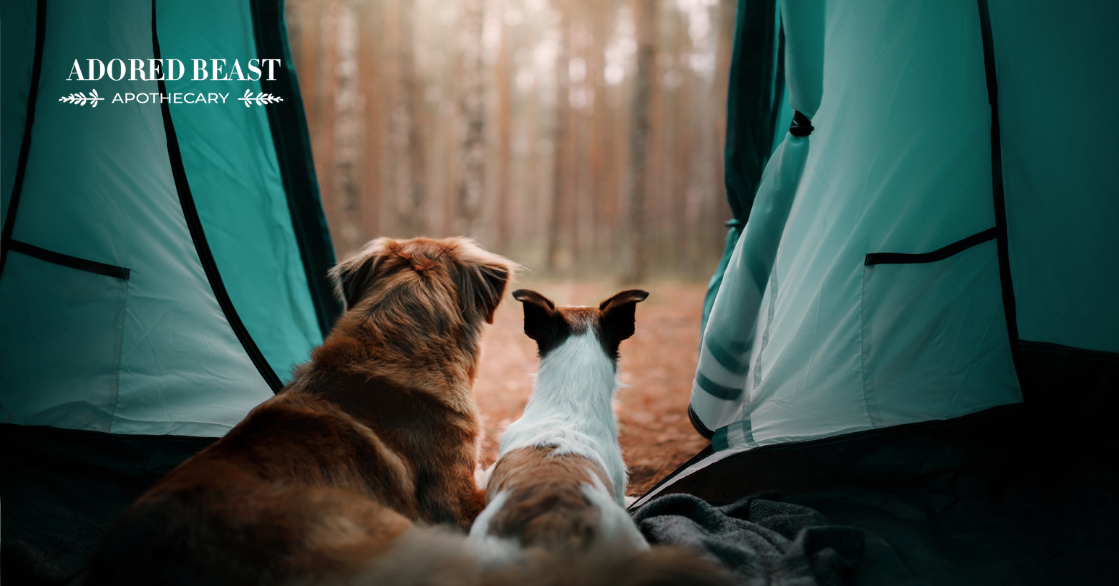In the summer months, nothing beats a weekend away, either in a tent, trailer, or under the stars, out in nature, living amidst the elements. All across North America, camping is a favoured pastime so many people make time for.
Several times a year we pack up the car, hook up the trailer, and head out. And while we don’t technically set up camp in the wilderness (we’re seasoned Provincial Park visitors), spending a few days in nature really helps reset the clock.
And the dogs always come along for the adventure. But camping with a dog does take a little extra work. This week, we’ve got the tips and tricks to make that getaway with your pup easy.
🏕️ Tips and Tricks for Camping with a Dog
Check Campground Rules and Regulations
In today’s increasingly dog-friendly society, many, many campgrounds allow pets. But, it’s always good to check before you book. Additionally, if dogs are allowed, there may be some rules you’ll need to follow. These may include:
- Keeping them on leash: We set up a perimeter and tie a light long line to something central. That way, Indi has room to roam, but stays within the boundaries of our site. Remember: never leave them unattended tied-up outside.
- Excessive noise: Is your dog a barker? Keep in mind that some dogs will be more vocal in the new environment (Indi was the first time we took her), so consider ways to distract them.
- Where they can go: We always camp at parks with a dog beach and trails. But not all parks offer these, or offer dog-friendly options. Some parks have beaches, but dogs may not be allowed.
Sun or Shade?
In the heat of the summer, camping with a dog can present a challenge. Make sure that you get a site that has plenty of shade – you don’t want your dog to be stuck in the sun all day. Think about ways to create a cool place for your pup to relax – an open-sided tent or tarps fastened to some trees.
Also, if you’re camping in a tent, don’t rely on it for daily shade. Because they’re enclosed, it can get really warm inside, and that can be dangerous. If you have an electric site, consider a small fan to increase air flow, even if you’re just in the tent at night. Even the summer nights may not offer the cooling relief to keep your pup comfortable.
What’s on the Menu?
If your pets eat kibble, dehydrated, or freeze-dried food, your task is a little easier, but if they eat raw food, you need to plan for that. If you don’t have access to a fridge, again, a cooler works just as well. For example, when we camp, we pack according to what’s eaten first. That way, food defrosts quicker on top, and is used first, while the stuff on the bottom stays colder, longer. Consider two coolers – one that stays closed the whole time, until the food is needed, to keep it from defrosting too quickly.
Water is another consideration – one we always forget about! Some dogs can be picky with water, so we fill up our large reusable water jugs with water from home, so Indi has her own water. If you’re gone for a longer time than that water from home will last, slowly blend the old with the new over time so it’s not an all-at-once switch.
Proper Camping Gear
When we camp, we have specific gear we take with us. For example, Indi wears a collar with a light on it at night, or you can get a reflective harness to make it easier to see your dog in the dark. Indi also has a camping bed – a raised one, to keep her off the ground. And there are even dog leashes specifically intended for swimming. They have anti-rust clips and float on the water, making them easier to grab. We also always bring an extra leash, just in case. Collapsible bowls are handy for daily hikes and puzzle toys are good for some relaxing mental stimulation.
And don’t forget the dog-safe bug spray!! Here are 3 recipes we like!
ID Up-to-date?
This one’s a no brainer, but you always want to make sure that you have up-to-date identification, and that your pet is wearing it at all times. Just in case you and your pet get separated, your pet will be able to make her way back to you!
Camping First-aid Kit
We never embark on a camping trip without our pet-friendly first-aid kit. Like a good boy scout, it’s always good to be prepared. Always carry your dog’s first-aid kit with you while camping, participating in off-site activities and when traveling.
Here’s what’s in our camping first-aid kit:
- ABA camping essentials: Jump for JOYnts, Gut Soothe, Skin HEALth Spray
- Gauze or cotton swabs (not cotton balls! they leave little strands and can cause infection)
- Non-stick Bandages or Wraps
- Medical tape, scissors, tweezers
- A tick removal tool (here’s how to use it properly)
- A towel or cloth
- Clean water
- Saline solution (make your own by adding 1/4 teaspoon of table salt to one cup of purified water)
- Packages of electrolytes (without xylitol or aspartame). This can be really helpful if there is dehydration and you are far away backpacking until you get to a vet.
- A needle-less syringe (for easy administration of electrolytes)
Like or Dislike?
This is important. Despite how much you love camping, it may not be your dog’s thing. Indi loves camping. And back when Inuk was young, she did too, but in her later years, she grew less fond of it. So, when we camped, she went to stay with her grandparents. That was much more her style.
Camping can be a lot for a dog. They’re exposed to a completely new environment: new sights, new sounds, new smells. It can be overwhelming. Give them time to get accustomed, and try to make it as comfortable as possible. You can even do a trial run by spending the night in the tent in the backyard, or in the trailer in the driveway. But if, in the end, they just don’t like it, don’t force it.
🏕️ Camping with a dog can be so much fun. It’s a great way to get out in nature and refresh, and an amazing way to connect with your animal. With a few simple tips and tricks, camping can be safe and enjoyable.












